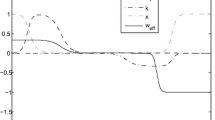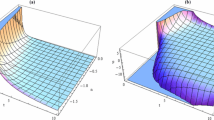Abstract
In this work, we consider the Palatini \(f(R)\) gravity theory with the matter dominated universe. Utilizing the dynamical equivalence between Palatini \(f(R)\) gravity and Brans-Dicke like scalar tensor theory, we obtain a point-like Lagrangian for the locally rotational symmetric Bianchi I space time. We determine the physically interesting functional forms of \(f(R)\) for this Lagrangian via Noether symmetry approach. We also explore some cosmological solutions of the field equations using these forms obtained by the existence of Noether symmetry. It is shown that these solutions are consistent with the accelerated behavior of the universe.






Similar content being viewed by others
References
Akarsu, O., Kilinc, C.B.: Gen. Relativ. Gravit. 42, 119–140 (2010)
Akarsu, O., Dereli, T., Oflaz, N.: Class. Quantum Gravity 31, 045020 (2014)
Amarzguioui, M., Elgaroy, O., Mota, D.F., Multamaki, T.: Astron. Astrophys. 454, 707–714 (2006)
Armendariz-Picon, C., Greene, P.B.: Gen. Relativ. Gravit. 35, 1637 (2003)
Aslam, A., Jamil, M., Myrzakulov, R.: Phys. Scr. 88, 025003 (2013)
Bengochea, G.R., Ferraro, R.: Phys. Rev. D 79, 124019 (2009)
Bennett, C.N., et al.: Astrophys. J. Suppl. Ser. 148, 1–27 (2003)
Bertolami, O., Bochmer, C.G., Harko, T., Lobo, F.S.N.: Phys. Rev. D 75, 104016 (2007)
Brax, P., van de Bruck, C., Davis, A.C., Shaw, D.J.: Phys. Rev. D 78, 104021 (2008)
Caldwell, R.R.: Phys. Lett. B 545, 23–29 (2002)
Camci, U., Kucukakca, Y.: Phys. Rev. D 76, 084023 (2007)
Campanelli, L., et al.: Int. J. Mod. Phys. D 20, 1153 (2011)
Capozziello, S., de Ritis, R.: Phys. Lett. A 177, 1–7 (1993)
Capozziello, S., de Ritis, R., Rubano, C., Scudellaro, P.: Riv. Nuovo Cimento 19, 1–114 (1996)
Capozziello, S., Marmo, G., Rubano, C., Scudellaro, P.: Int. J. Mod. Phys. D 6, 491–503 (1997)
Capozziello, S., De Laurentis, M., Odintsov, S.D.: Mod. Phys. Lett. A 88, 025003 (2014)
Collins, C.B., Glass, E.N., Wilkinson, D.A.: Gen. Relativ. Gravit. 12, 805–823 (1980)
Copeland, E.J., Sami, M., Tsujikawa, S.: Int. J. Mod. Phys. D 15, 1753–1935 (2006)
Copi, C.J., Huterer, D., Schwarz, E.J., Starkman, G.D.: Phys. Rev. D 75, 023507 (2007)
De Felice, A., Tsujikawa, S.: Living Rev. Relativ. 13, 3 (2010)
De Souza, R.C., Kremer, G.M.: Class. Quantum Gravity 25, 225006 (2008)
De Souza, R.C., Andre, R., Kremer, G.M.: Mod. Phys. Lett. A 87, 083510 (2013)
Durrer, R., Maartens, R.: Gen. Relativ. Gravit. 40, 301–328 (2008)
Fazlpour, B., Banijamali, A.: Adv. High Energy Phys. 2013, 279768 (2013)
Flanagan, E.E.: Phys. Rev. Lett. 92, 071101 (2004)
Gecim, G., Kucukakca, Y., Sucu, Y.: Adv. High Energy Phys. 2015, 567395 (2015)
Geng, C.-Q., Lee, C.-C., Saridakis, E.N., Wu, Y.-P.: Phys. Lett. B 704, 384 (2011)
Guo, Z.K., Piao, Y.S., Zhang, X.M., Zhang, Y.Z.: Phys. Lett. B 608(3), 177–182 (2005)
Hussain, I., Jamil, M., Mahomed, F.M.: Astrophys. Space Sci. 337, 339 (2012)
Jamil, M., Ali, S., Momeni, D., Myrzakulov, R.: Eur. Phys. J. C 72, 1998 (2012)
Kucukakca, Y.: Eur. Phys. J. C 73, 2327 (2013)
Kucukakca, Y.: Eur. Phys. J. C 74, 3086 (2014)
Kucukakca, Y., Camci, U.: Astrophys. Space Sci. 338, 211–216 (2012)
Kucukakca, Y., Camci, U., Semiz, I.: Gen. Relativ. Gravit. 44, 1893–1917 (2012)
Li, E.-N., Zhang, Y., Geng, J.-L., Duan, P.-F.: Gen. Relativ. Gravit. 47, 136 (2015)
Myrzakulov, R.: Eur. Phys. J. C 71, 1752 (2011)
Netterfield, C.B., et al.: Astrophys. J. 571, 604–614 (2002)
Noether, E.: “Invariante Variationsprobleme,” Nachr. Ges. Wiss. Gott., Math.-Phys. Kl., pp. 235–257 (1918), English translation in Transp. Theory Stat. Phys. 1(3), 186–2079 (1971)
Nojiri, S., Odintsov, S.D.: Phys. Lett. B 631, 1–7 (2005)
Nojiri, S., Odintsov, S.D.: Phys. Rep. 505, 59–144 (2011)
Olmo, G.J.: Int. J. Mod. Phys. D 20, 413–462 (2011)
Perlmutter, S., et al.: Astrophys. J. 517, 565 (1999)
Ratra, B., Peebles, P.J.E.: Phys. Rev. D 37, 3406–3427 (1988)
Ribas, M.O., Devecchi, F.P., Kremer, G.M.: Europhys. Lett. 81, 19001 (2008)
Riess, A.G., et al.: Astrophys. J. 116, 1009 (1998)
Roshan, M., Shojai, F.: Phys. Lett. B 668, 238–240 (2008)
Sharif, M., Shafique, I.: Phys. Rev. D 90, 084033 (2014)
Sharif, M., Shafique, I.: J. Exp. Theor. Phys. 120, 49–59 (2015)
Sharif, M., Waheed, S.: J. Cosmol. Astropart. Phys. 2013, 043 (2013)
Sharif, M., Zubair, M.: Astrophys. Space Sci. 339, 45–51 (2012)
Sotiriou, T.P.: Class. Quantum Gravity 23, 5117–5128 (2006)
Sotiriou, T.P., Faraoni, V.: Rev. Mod. Phys. 82, 451–497 (2010)
Tegmark, M., et al.: Phys. Rev. D 69, 103501 (2004)
Vakili, B., Jalalzadeh, S., Sepangi, H.G.: J. Cosmol. Astropart. Phys. 05, 006 (2005)
Wang, X.X.: Chin. Phys. Lett. 21, 1205–1207 (2004)
Watanabe, M., Kanno, S., Soda, J.: Phys. Rev. Lett. 102, 191302 (2009)
Wei, H.: Phys. Lett. B 12, 430 (2012)
Wei, H., Guo, X.-J., Wang, L.-F.: Phys. Lett. B 707, 298–304 (2012)
Xu, C., Saridakis, E.N., Leon, G.: J. Cosmol. Astropart. Phys. 7, 005 (2012)
Zhang, Z., Dong, Y.Q.: Astrophys. Space Sci. 359, 16 (2015)
Zhang, X., Wu, F.Q., Zhang, J.: J. Cosmol. Astropart. Phys. 2006, 003 (2006)
Zlatev, I., Wang, L.M., Steinhardt, P.J.: Phys. Rev. Lett. 82, 896–899 (1999)
Acknowledgements
This work was supported by Akdeniz University, Scientific Research Projects Unit. The author would like to thank the anonymous referee for the enlightening comments on the paper.
Author information
Authors and Affiliations
Corresponding author
Appendix: Noether symmetries with gauge term
Appendix: Noether symmetries with gauge term
In the case of \(B\neq0\) and \(\tau\neq0\), Noether gauge symmetry equations given by (27)–(33) yield following two solutions,
with the potential (43) and
with the potential (46). In the above solutions, \(c_{i}\) \((i=1,2,3,4)\) are a redefined integration constants. Considering the first of above solutions, we obtain three Noether symmetries of the Lagrangian (15) which are
The first symmetry \(\mathbf{X}_{1}\) (corresponds to translations in time) gives the energy conservation of the dynamical system in the form of (94) below, while the second and third symmetries \(\mathbf{X}_{2}\) and \(\mathbf{X}_{3}\) generate the constants of motions of the form (95) and (96) below, respectively. The non-commuting generators \(\mathbf{X}_{i}\) satisfy the algebra given by
The corresponding constants of motion associated with the above Noether symmetries are
Rights and permissions
About this article
Cite this article
Kucukakca, Y. Anisotropic solution via Noether symmetry for \(f(R)\) Palatini gravity. Astrophys Space Sci 361, 80 (2016). https://doi.org/10.1007/s10509-016-2667-6
Received:
Accepted:
Published:
DOI: https://doi.org/10.1007/s10509-016-2667-6




